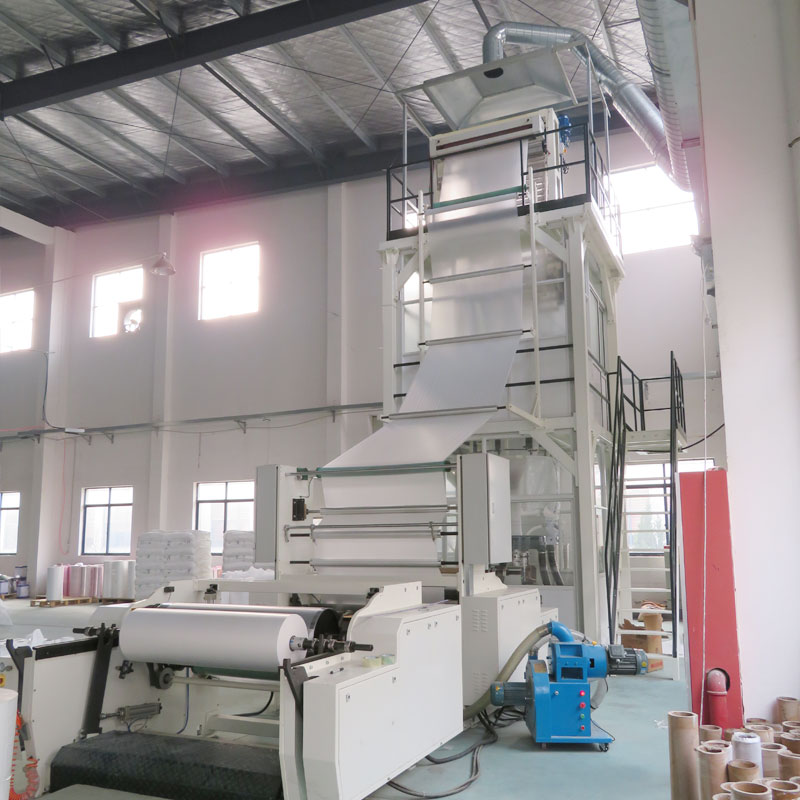What Makes Blown Film Machines the Backbone of Modern Packaging Production?
2025-10-15
In the dynamic landscape of plastic packaging manufacturing, blown film machines play a pivotal role in shaping high-quality plastic films used across industries. From food packaging and agricultural film to industrial liners and shrink wraps, these machines provide the foundation for flexible, durable, and sustainable packaging solutions. A blown film machine extrudes molten plastic through a circular die, inflates it into a thin bubble, and then cools and flattens it into continuous film rolls.
The significance of blown film technology lies in its ability to produce films with customized thickness, superior strength, and excellent barrier properties. As global demand for eco-friendly packaging grows, modern machines have evolved to support multi-layer co-extrusion, energy-efficient cooling systems, and advanced automation controls, making them indispensable for manufacturers seeking both productivity and sustainability.
The core objective of this article is to explore what makes blown film machines essential, why they are increasingly preferred in modern production lines, and how their innovative designs shape the future of packaging technology.
Why Blown Film Machines Are Transforming the Packaging Industry
Advantages and Functional Innovations
Blown film machines have advanced far beyond basic extrusion. Today’s models integrate precision engineering with intelligent control systems to deliver exceptional performance. Below are the primary advantages that make them stand out in the packaging world:
| Key Feature | Description | Impact on Production |
|---|---|---|
| High Output Rate | Advanced extrusion screws and optimized die design | Increased production speed and film consistency |
| Multi-Layer Co-Extrusion | Ability to combine different polymers in 3–9 layers | Enhanced film strength, barrier, and transparency |
| Automatic Thickness Control (ATC) | Real-time measurement and correction of film gauge | Reduced waste and uniform product quality |
| Energy-Efficient Cooling System | Optimized air ring and internal bubble cooling | Lower energy consumption and faster cooling times |
| Digital Automation & PLC Interface | Full machine control with smart software | Simplified operation, reduced human error |
| High-Precision Winding System | Automatic tension adjustment for even rolls | Smooth winding and reduced material deformation |
Industry Benefits
The transition toward sustainable and smart packaging has made blown film machines a central component of industrial manufacturing. They enable businesses to:
-
Minimize material waste through precise thickness control.
-
Enhance productivity with continuous, high-speed operation.
-
Support eco-friendly films by using biodegradable or recyclable resins.
-
Improve brand competitiveness through superior packaging quality and clarity.
These advantages highlight why global manufacturers—from food processors to agricultural suppliers—are shifting to high-performance blown film systems to meet evolving market expectations.
How Blown Film Machines Work: Inside the Technology
The production of blown film follows a precise process that transforms polymer granules into durable, flexible plastic films. Understanding the process reveals how every technical detail contributes to the machine’s efficiency and film quality.
The Extrusion Process
-
Feeding and Melting – Plastic resin (usually LDPE, LLDPE, HDPE, or blends) is fed into the extruder hopper, where rotating screws melt and homogenize it.
-
Die Head & Inflation – The molten polymer passes through an annular die to form a thin tube. Air is introduced to inflate this tube into a bubble, determining film diameter and thickness.
-
Cooling & Stabilization – Cooling air is applied to solidify the film bubble. Internal bubble cooling systems improve film transparency and surface quality.
-
Flattening & Hauling – The film bubble is collapsed by nip rollers into double-layer sheets, then guided upward through a tower structure.
-
Winding – The film passes through tension-controlled rollers to ensure smooth and even winding.
Technical Parameters (Typical Range)
| Parameter | Specification Range | Explanation |
|---|---|---|
| Film Width | 500 mm – 3000 mm | Defines the maximum lay-flat film width |
| Film Thickness | 10 µm – 250 µm | Adjustable based on end-use requirements |
| Output Capacity | 50 – 300 kg/hour | Varies with machine size and screw diameter |
| Screw Diameter | 45 – 120 mm | Determines extrusion volume and melt rate |
| Power Requirement | 30 – 120 kW | Dependent on motor capacity and cooling system |
| Layer Configuration | Mono / 3 / 5 / 7 layers | Enables functional film design and barrier control |
| Material Compatibility | LDPE, LLDPE, HDPE, EVA, Biodegradable polymers | Supports diverse packaging applications |
Each element—from screw design to air ring precision—contributes to consistent film performance, reduced downtime, and minimal operational costs.
Future Trends: Where Blown Film Machines Are Heading
The future of blown film technology aligns with global trends toward automation, sustainability, and digital transformation. Manufacturers are investing in next-generation systems that promise efficiency and environmental responsibility.
Sustainable Materials and Green Packaging
The global focus on eco-friendly packaging is pushing producers to adopt biodegradable and compostable materials. New blown film machines are designed to process resins such as PLA, PBAT, and starch-based compounds, ensuring that film strength and clarity are maintained while reducing environmental impact.
Additionally, machine manufacturers are introducing energy recovery systems and intelligent temperature control units to reduce power usage by up to 30%. These advancements support both cost efficiency and corporate sustainability goals.
Smart Automation and IoT Integration
Modern blown film machines are now equipped with IoT-enabled monitoring, allowing operators to track performance metrics in real-time. Predictive maintenance alerts help prevent breakdowns, while digital twin technology simulates film behavior for faster product development.
AI-driven automation (in industrial control contexts) has streamlined the extrusion process—adjusting cooling rates, air pressure, and speed dynamically to maintain perfect film balance and thickness. The result is higher consistency, lower waste, and minimal manual intervention.
Global Market Outlook
As e-commerce, food delivery, and agricultural packaging continue to expand, the demand for flexible film materials is expected to surge. According to market trends, Asia-Pacific and Europe are projected to lead global blown film machine installations, driven by packaging innovation and environmental regulations.
Blown film technology will remain a central force in packaging transformation, combining sustainability, speed, and precision to meet modern consumer demands.
Common Questions About Blown Film Machines (FAQ)
Q1: What types of films can be produced by a blown film machine?
A blown film machine can produce a variety of films, including LDPE film, HDPE film, LLDPE stretch film, shrink film, barrier film, and biodegradable film. These films are used in applications such as food packaging, shopping bags, agricultural mulch, industrial liners, and stretch wraps. By changing the material blend and layer configuration, manufacturers can tailor the film’s strength, transparency, and barrier properties to specific requirements.
Q2: How to choose the right blown film machine for production needs?
Choosing the right machine depends on several factors:
-
Film Application – Identify whether it’s for food packaging, agriculture, or industrial use.
-
Material Type – Select a machine compatible with the polymer grade you intend to process.
-
Production Capacity – Consider required output (kg/hour) and film width.
-
Number of Layers – Decide between mono-layer, three-layer, or multi-layer systems depending on the need for film strength or barrier properties.
-
Automation Features – Modern PLC systems and auto gauge controls improve consistency and reduce waste.
An experienced supplier will evaluate these needs and recommend the ideal model for your production goals.
Advancing Toward Smarter, Greener Film Production
Blown film machines have redefined the standards of packaging manufacturing by combining engineering precision, operational efficiency, and environmental responsibility. As global markets shift toward recyclable and biodegradable materials, these machines continue to evolve—integrating advanced cooling technologies, automation, and multi-layer extrusion systems that enhance film performance and sustainability.
In this transformation, Mul-Plus stands at the forefront, offering high-performance blown film machines designed to meet modern manufacturing challenges. Each system is built with durability, accuracy, and productivity in mind—empowering businesses to achieve consistent quality with reduced environmental impact.
For companies seeking to elevate their film production efficiency or explore customized blown film solutions, contact us to discover how advanced engineering and dedicated service can transform your packaging operations.



